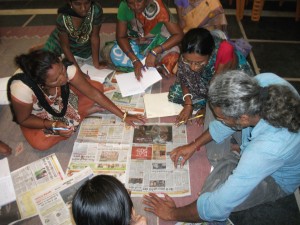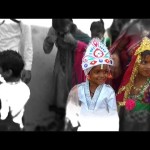 These days, it seems that you can find practically everything and everyone on the Internet, right? Thanks to social media, you may have reconnected with the kid who sat behind you in primary school or you might routinely find the most obscure information online. So naturally, you think the Internet is a great equalizer. But not only is everything not searchable, less than 35 percent of the world’s population is on the Internet. For some people, a great deal of information is only a couple of keystrokes away but for much of the world—over 4.5 billion people—the information highway isn’t going to where they live. It also means that because so many people are left out from the so-called digital revolution, the things that happen to them cannot be covered in the news media. A statistic from India is representative of what happens in much of the world. In India, 70 percent of people live in rural areas, but on any given day, only 2 percent of the news is related to issues of rural people.
But there’s good news and this is where Video Volunteers comes in. When we started our organization in 2006, we knew that great strides in human rights and development could be made if and only if every community around the world had the power to communicate their issues, insights and the injustices they faced. Six years later, we’re happy to report that we are getting closer to our grand goal of ensuring that every village in the world has access to a resident ‘Correspondent Changemaker’—someone who reports and broadcasts local issues the way that community sees it, as opposed to how outsiders think the story will sell.
Video Volunteers started under extremely challenging circumstances. For example, video cameras and other documentation equipment were quite costly in 2006. However, a few years later, affordable technologies such as video-enabled telephones flooded the Indian market. This was a tremendous leg up for VV and our vision. And with more and more Indians owning mobile phones—now 75 percent—we knew the wind was at our back. We still face grave challenges because many of our community correspondents live in remote areas that have not been wired for the World Wide Web. After all, it is estimated that only 5-7 percent of Indians are on the Internet today.
But how far we’ve come! Every year, we’ve inched further and further away from what at times have felt like such intractable challenges. This year has been no exception.
Check out how we did this year:
National Advocacy to end Untouchability
These days, it seems that you can find practically everything and everyone on the Internet, right? Thanks to social media, you may have reconnected with the kid who sat behind you in primary school or you might routinely find the most obscure information online. So naturally, you think the Internet is a great equalizer. But not only is everything not searchable, less than 35 percent of the world’s population is on the Internet. For some people, a great deal of information is only a couple of keystrokes away but for much of the world—over 4.5 billion people—the information highway isn’t going to where they live. It also means that because so many people are left out from the so-called digital revolution, the things that happen to them cannot be covered in the news media. A statistic from India is representative of what happens in much of the world. In India, 70 percent of people live in rural areas, but on any given day, only 2 percent of the news is related to issues of rural people.
But there’s good news and this is where Video Volunteers comes in. When we started our organization in 2006, we knew that great strides in human rights and development could be made if and only if every community around the world had the power to communicate their issues, insights and the injustices they faced. Six years later, we’re happy to report that we are getting closer to our grand goal of ensuring that every village in the world has access to a resident ‘Correspondent Changemaker’—someone who reports and broadcasts local issues the way that community sees it, as opposed to how outsiders think the story will sell.
Video Volunteers started under extremely challenging circumstances. For example, video cameras and other documentation equipment were quite costly in 2006. However, a few years later, affordable technologies such as video-enabled telephones flooded the Indian market. This was a tremendous leg up for VV and our vision. And with more and more Indians owning mobile phones—now 75 percent—we knew the wind was at our back. We still face grave challenges because many of our community correspondents live in remote areas that have not been wired for the World Wide Web. After all, it is estimated that only 5-7 percent of Indians are on the Internet today.
But how far we’ve come! Every year, we’ve inched further and further away from what at times have felt like such intractable challenges. This year has been no exception.
Check out how we did this year:
National Advocacy to end Untouchability
- In a country that denies the existence of caste discrimination, our Community Correspondents (CCs) documented untouchability practices across the country in 26 (and counting) powerful videos. These videos are the basis for our large national campaign for equality and dignity, called the Article 17 Campaign to End Untouchability.
- The Campaign is being drafted into a public Interest litigation where our videos will serve as legal evidence.
- Satyamev Jayate, one of the most successful social issue television programs in history, featured our India director’s work on untouchability. This prompted thousands of people – from young people, to journalists, to government agencies - to contact VV to get involved in the fight against untouchability.
- The IndiaUnhead program expanded to some of the most marginalized tribal regions in the country. We recruited and trained 28 Tribal (a.k.a Adivasi) correspondents this year, in parts of the country where the majority of the population is Adivasi, yet there isn’t a single Adivasi journalist.
- Their videos transformed the unheard, vulnerable voices of the tribal communities into a potent force. They spoke on corruption, poverty, starvation, lack of basic amenities and the oppression of the state.
- We trained 52 new CC’s to bring the total of CC’s trained in our IndiaUnheard program to 126 New Community Correspondents.
- Our correspondents have produced 365 Community Videos this year.
- In partnership with a UN agency, we developed and instituted a replicable model whereby 20 grassroots women are documenting, via video, the successes and challenges of self-help groups.
- Tehelka, CNN-IBN and Yahoo started distributing VV community reports. We took on numerous new online distribution partnerships including popular youth portals Youth Ki Awaaz and Halabol.
- Aljazeera, BBC Radio, NPR, NDTV and AFP covered VV—our best year for press!
- VV won The Edelgive Social Innovations Award, WSIS Changemakers Award, and received the Ashoka Fellowship.
- Presented at 2 TEDx events, at the World Summit of the Information Society in Geneva, Oxfam Germany, CRY, Human Rights Law Newtork, IIT Delhi-Harvard, Population Council, THiNK, National Alliance of People’s Movements, and International Dalit Solidarity Network.
- Developed partnerships with V4C, community radio secretariat, Center for Protection of Journalists, HRLN, WITNESS, ESCR-Net, Gram Vaani and UNDP, Clinton Global Initiative
Pay By the Cellular Gambling enterprises In britain, Finest Pay By Mobile phone Gambling enterprises
Pay By the Cellular Gambling enterprises In britain, Finest Pay By Mobile phone Gambling enterprises Articles Best Uk Online casino games What are the Almost every other Certificates An excellent Uk Gambling establishment Can have To Getting Courtroom? Faqs For the Greatest Cellular Casinos In the uk The most popular...
Impact Story
The happiness that comes with an yearly bonus
This video is a story of success, a story of a small win against a giant corporation. A story of persistence and a never-say-die attitude. This year, the workers of 3 gardens in the Alipurduar area of Kumargram Block, received a slightly increased yearly bonus, an increase of 3%, from...

